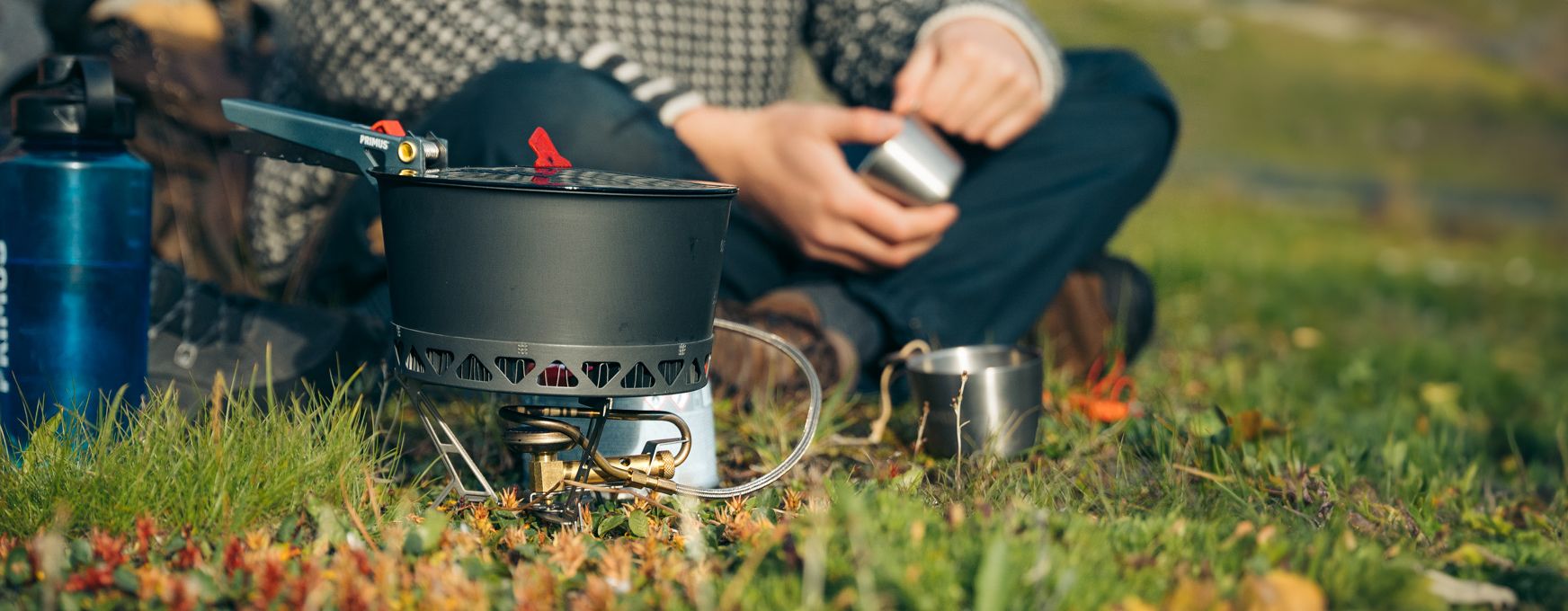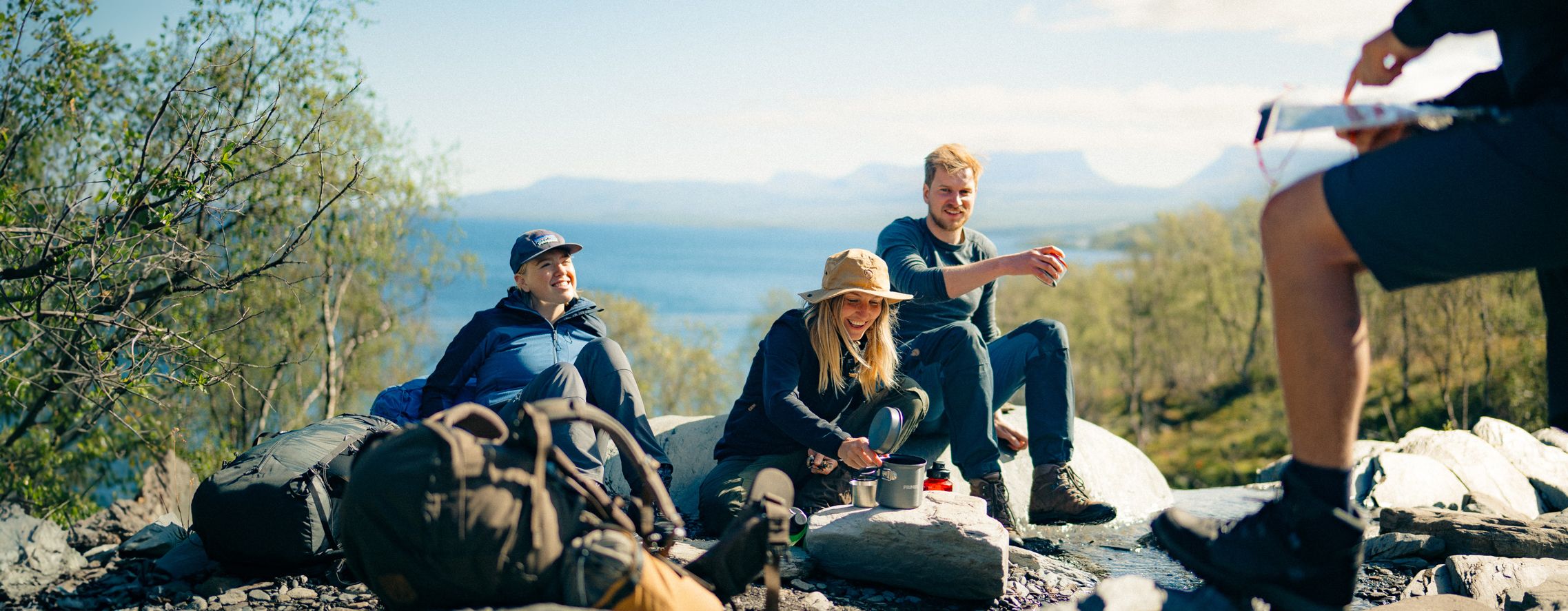

PRIMUS
Sustainable and tasty food for the five-day walk
Embarking on a five-day hike on our Swedish hiking trails is a fantastic nature experience and a welcome break from the noise of everyday life. But for the experience to be as good as possible, it is important to have good and energy-rich outdoor food in your backpack. Planning a good menu and packing the food in a sustainable and efficient way is therefore important. Both to know what order to cook your meals in and to make it quick and easy once you’re out on the trails.
Plan your menu
Start by writing down a proposed menu in a notebook. The type of stove you bring on the trip will obviously affect the type of meals you can prepare. A good basic principle is to choose a varied menu of tasty meals that are low in weight, high in calories and long lasting. Energy goes fast on the hike, so fill up as much as you can to keep your energy up.
A good basic rule to follow is that breakfast should provide plenty of energy for the day's activity. At lunchtime, you are often hungry and want the food to be relatively easy and quick to prepare. Dinner, on the other hand, can be given a little extra care when you have set up camp for the night. And don't forget to enjoy yourself and add a little something extra to your hike by packing some desserts and a chocolate bar. It's a much-needed reward after a day on the trail.
Plan your meals according to the weight and shelf life of the food and eat the heaviest meals early in the hike to make your backpack lighter and easier to carry. If there are more people on the hike, divide the food between you so that everyone on the hike can help carry it.
Pack your food efficiently and sustainably
Pack all food items in airtight, sealable portion bags. Use one bag for each meal for easy separation. Label the bags with the name of the dish and the amount of water that needs to be added for quick preparation. A good tip is to have a separate bag for butter, spices, oils, or anything else you use at each meal. And make sure you have enough food for at least an extra day on the trip in case you are delayed or someone gets injured on the hike. A good tip is to repack your backpack every morning so that the day's meals are high up in your backpack and easy to access.
How long food lasts on the trail
When on a multi-day hike in the summer, choose foods with a long shelf life. In winter, when it's colder, you can also opt for the occasional shorter shelf-life item as long as you keep them cold on the way to the hike. Eat the meals that contain perishable ingredients first.
Fresh food that works on the trail (and lasts a few days without refrigeration):
Boiled eggs
Salami or smoked ham
Butter
Hard cheese, such as parmesan
Butter and cheese are high in fat, provide good energy and usually last several days if handled properly. Even cream can last almost a week if you don't open and close the package too many times.
Dry ingredients for hiking
All types of dried food are suitable for a few days of hiking – dried food weighs about one tenth as much as fresh food. Dried food also has a small packing volume and lasts much longer than fresh food. You can either buy pre-dried ingredients or freeze-dried meals in ready-to-eat portions. Another fun option is to try drying your own food at 70 degrees in your home oven, which makes it easier for you to take your favorite meals on your trip. Dried animal foods and high-fat foods last between one and two weeks once dried, while dried fruit, mushrooms, and vegetables last much longer than that.
Supplement with dry foods such as muesli, oatmeal, rye flakes, noodles, rice, and pasta. These practically last forever. And don't forget to bring biscuits, cakes, nuts, dried fruit, and other items to spice up your meals and provide much-needed energy during your hike.
Which ingredients should I avoid?
Fresh meat, fish and chicken will go bad quickly if left warm in your pack on the trail. Other than that, there are really no raw materials that you need to exclude completely. It all comes down to the longevity of the food, when you eat it, and how much weight you want to carry. If you have no problem carrying a heavier pack, it may be worth treating yourself to some fresh ingredients during the first few days of hiking and then switching to dry goods later.
Don't forget water
Water is a necessity when hiking, both for cooking and for getting the amount of fluids you need to stay hydrated. An adult needs to drink 2.5 liters of water every day and even more during physical activity. Fill your bottle or hydration system with plenty of water before you start your day's hike. If you are hiking in the mountains, you can fill up with fresh water in the streams as you pass by.
Use the map to plan your stops so that you always stop or camp near water. If there is no clean water along the way, you need to purify the water with water filters or water purification tablets. You can also boil the water for two minutes to get rid of bacteria, viruses, and parasites.
Suggested recipes for the hike:
February 07 2022








